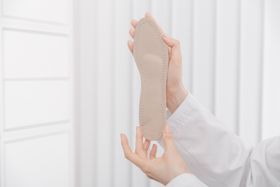Best Exercises for Posterior Tibial Tendonitis
Updated December 18, 2024.

Posterior tibial tendonitis, also known as posterior tibial tendon dysfunction (PTTD), is caused by the inflammation of the posterior tibial tendon that is responsible for plantar flexion (flexing your toes toward your sole) and inversion of the foot. This results in pain in the ankle and the foot and an inability to stabilize the foot during gait. Posterior tibial tendonitis is a common foot condition and must be managed promptly, or else it will lead to more debilitating conditions.
This article briefly discusses some common causes and treatments for PTTD but looks more specifically at various exercises you can perform at home to aid in the healing process.
Possible Causes of Posterior Tibial Tendonitis
Posterior tibial tendonitis often occurs as a repetitive injury due to overuse. It is most common among dancers and athletes involved in high-impact sports. It can also occur acutely with a fall or collision involving the posterior tibial tendon. Generally, women and people over 40 years of age are more prone to having posterior tibial tendonitis.
» Do you feel feet and ankle pain after walking or hiking? Consider investing in fitness walking and hiking custom orthotics to relieve pain, but make sure to read product reviews before purchasing
Common Treatments for Posterior Tibial Tendonitis
Posterior tibial tendonitis is best managed early. Treatment options include rest, activity modification, ice, NSAIDs, braces, orthotics, cortisone injections, and exercises.
In the case of orthotics for posterior tibial tendonitis, they must be custom-built based on the condition. Upstep orthotics are the best custom orthotics you can get, as they are designed by expert podiatrists using the best quality materials to fit your specific feet.
A cortisone injection is also helpful as it provides short-term relief and helps reduce inflammation. This is particularly useful if you’ll be carrying out an exercise regimen.
Apart from relieving pain, exercises can help strengthen the muscles of the lower extremity as well as stretch, improve, and maintain the mobility of the ankle joint. Here are some of the most common yoga-style exercises you can perform for posterior tibial tendonitis:
Stretching Exercises for Posterior Tibial Tendonitis
1. Hamstring wall stretch
Starting position: Supine lying (lying on your back)
- Lie on your back next to a wall.
- Keeping the unaffected leg flat against the floor, slowly slide the affected leg up the wall as if to straighten the knee, ensuring that you do not arch your back or bend a knee while doing this. Note: As the knee on the affected leg straightens, you’ll feel a stretch down your hamstring muscles.
- Hold the stretch for a minimum of 1 minute to begin, then continue to lengthen the duration of the stretch as your body adapts to it.
- Repeat 2 to 4 times.
2. Calf wall stretch
Starting position: Standing
- Stand facing a wall with your hands against it at about eye level.
- Put your affected leg about a step behind your other leg.
- With your leg straight and your heel on the floor, bend the knee of the unaffected leg and gradually bring your hip and chest toward the wall. Note: Alternatively, you can start by bending both knees while keeping both heels on the floor. Again, slowly bring the hips and chest back towards the wall. In both cases, you’ll stop when you feel a stretch in the calf of your back leg.
- Hold the stretch for up to 30 seconds.
- Repeat 2 to 4 times for a set.
3. Shin muscle stretch
Starting position: Sitting
- Keep your feet flat on the floor while sitting in a chair.
- Transfer weight to your toes by bending the feet, causing the toes to point downwards at the floor. You can hold the chair for support.
- Once done, you’ll begin to feel a stretch in the front of your shin.
- Hold the stretch for at least 15 to 30 seconds.
- Repeat 2 to 4 times.
Strengthening Exercises for Posterior Tibial Tendonitis
1. Ankle inversion with resistance band
Starting position: Sitting
- Start with both feet flat on the ground sitting with your back straight.
- Place the lateral border of the affected foot on the knee of the other leg. You can use your hand to stabilize the affected leg at the knee.
- With your other foot firmly on the ground, pull the resistance band towards the affected leg, letting it rest on the ball of your feet.
- Slowly invert the foot by pulling on the resistance band. You can support the foot with your hand.
- Repeat 3-10 times.
2. Forward step downs (for the quads and soleus)
Starting position: Standing
- Begin with the affected foot on an elevated surface. You could use a small box or the last step on a flight of stairs.
- Keeping your head and back straight, bend your knee forwards until the heel of the other foot is almost touching the floor.
- Slowly return to the starting position.
- Repeat 10 times.
Importance of Post Care and Exercise
It should be noted that exercise doesn’t bring instant results regarding posterior tibial tendonitis. Rather, the goal is to remodel and reeducate the muscles, strengthening and stretching them in the process. This takes some time, so you must be consistent in performing the exercises until they yield results.








